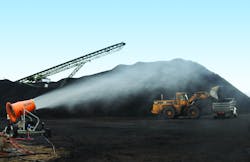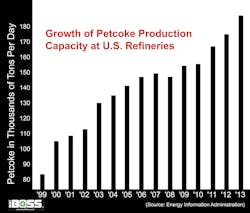Recent environmental regulations present a difficult challenge to dust management for petroleum coke (petcoke) processing and storage operations. Tight restrictions on dust emissions now mandate that storage piles be housed in full enclosures. The U.S. and other nations have deemed petcoke dust, a byproduct of the oil refining process used for applications including cement additive and affordable carbon fuel, to be hazardous when inhaled.
The most common way to control dust from outdoor storage piles is with water, but moisture content above 8 percent and an increased net weight can have a severe impact on the price per ton of petcoke.
Smaller companies with tight profit margins are finding that proposed regulations could significantly raise operation costs and affect prices. Regardless of the standards enacted by regulators in each municipality, measurable dust emissions are required by federal law to be controlled, causing many firms to turn to antiquated solutions that actually exacerbate the problem.
In an attempt to mitigate dust, many operations installed high-pressure sprinkler systems that use hundreds of gallons of water per minute, resulting in high water costs, material saturation and runoff. This leads to further regulatory involvement regarding wastewater, and it introduces an undesirable increase in moisture content. Moreover, sprinkler systems don’t really control airborne dust.
Irrespective of the industry’s good-faith efforts, concerned municipalities and local governments have begun to consider ordinances similar to one imposed by the city of Chicago, which mandates that petcoke handlers move operations into sealed, emission-free enclosures. This caused small facilities in the city to shut down because indoor storage is only economically viable for companies financially prepared to incur the high cost.
Under these circumstances, operations of all sizes have taken notice of a dust suppression technology embraced by the coal industry.
Addressing similar regulations, atomized mist is used to mitigate dust emissions both in the air and on the surface of coal storage piles, with only trace amounts of runoff. Using far less water than large sprinkler systems, airborne mist helps processing operations and transfer stations stay compliant with current standards and potentially avoid further regulations regarding their wastewater. Additionally, the technology drastically reduces the moisture content of the saleable product.
Bellwether legislation in Chicago
According to the Energy Information Administration (EIA)¹, since 1999, the amount of petcoke exported from the U.S. has doubled to hundreds of tons per day, increasing the amount of dust produced from outdoor storage facilities. This prompted South Side Chicago residents living near the Koch Industries KCBX facility to file a lawsuit in 2014, accusing the terminal of polluting the local air and water.
In response to years of complaints from residents prior to the filing, KCBX spent $10 million to install 42 rotating water cannons mounted on 60-foot poles. The approach had limited success controlling the dust, and the lawsuit suggests the equipment may have made things worse, alleging that, "Periodic overwatering of these surfaces can contribute to conditions that allow petroleum coke, coal and/or dusts of these materials to enter local storm drains and waterways."
The lawsuit characterizes petcoke as a toxic pollutant, but industry representatives have pointed out that the substance doesn’t fit the U.S. Environmental Protection Agency’s (EPA) definition of a pollutant.² Consisting almost completely of carbon, the commodity is traded on the futures exchange alongside crops, minerals and dried bulk goods such as coffee. Proponents reason that a tradable and transportable inert, non-toxic substance should not be considered a hazardous waste product or a pollutant.
Petcoke dust is a byproduct of the oil refining process used for applications including cement additive and affordable carbon fuel.
Without awaiting resolution of the lawsuit, the Chicago City Council passed regulations in December 2014 that require petcoke and coal storage companies within the Chicago city limits to completely enclose operations. This forced the closure of a mid-sized Chicago area petcoke storage facility owned by Beemsterboer Slag Corp. However, KCBX submitted plans to build a $120 million enclosure on its existing site, measuring 1000 feet long by 200 feet wide by 100 feet high, that would contain the entire operation by 2017.
KCBX’s agreement to these demands caught the attention of stakeholders in the petcoke and coal industries, who are monitoring the issue closely. Concerned that this may set off a trend in other U.S. municipalities resulting in the closure of dozens of smaller facilities across the country, petcoke facility operators are seeking alternatives to current, marginally effective dust suppression methods.
Dust suppression science
One reason industrial sprinkler systems like those used by KCBX are unsuccessful at managing airborne dust is because of the slipstream effect, which prevents large droplets of water from effectively capturing small airborne dust particles. When droplets fall, they cause air molecules to move around them in a current called a slipstream. The force of this effect is relative to the size and speed of the droplet. When small airborne particles encounter a large droplet such as those from a sprinkler, they can get caught in this current, causing them to deflect away from the droplet rather than colliding with it and being absorbed.
To improve the effectiveness of trapping airborne dust with water, a technology called variable particle sizing (VPS) is used to adjust the droplet size to match the size of the dust particles. According to the U.S. National Institutes of Environmental Health Sciences³, a cross section of the average human hair is about 100 microns (μ) in diameter, the same threshold at which the EPA considers dust to be inhalable through the nose and mouth. Dust particles that are 200 μ or smaller are able to linger in the air and travel on naturally occurring atmospheric currents. This is also true for water droplets. These particles and droplets are no longer visible to the naked eye below 50 μ.
In comparison, industrial sprinkler systems create droplets between 200 and 10,000 μ in size3, and atomized mist uses VPS to produce droplets between 50 and 200 μ. While sprinkler droplets quickly fall to the ground without encountering a high number of airborne dust particles, millions of atomized droplets are introduced into the atmosphere surrounding petcoke storage piles, traveling with the dust and colliding with the particles, absorbing them and using the collective mass to drive both to the ground.
Product loss and water usage
Industrial sprinkler systems may be unsuccessful at managing airborne dust because of the slipstream effect.
Rainfall, snow and ice runoff can be predicted through rainfall averages and accurate modern weather modeling as part of the engineering of a site’s water drainage. However, industrial sprinklers can erode an unreasonable amount of product, strain containment systems and introduce massive amounts of water, often exceeding even the hardest downpour.
For example, a hard 3-inch per hour rainfall on a 10,000-square-foot area will produce 18,700 gallons an hour at the rate of 312 gallons per minute (gpm). For many facilities, that is enough to flood catch basins and stress drainage systems. Large industrial sprinkler systems commonly used for dust suppression propel a long stream of water over storage piles, saturating the surface with a volume of 500 gpm within a typical coverage area of 91,476 to 396,396 square feet.4
By using high-powered industrial sprinklers, water can become a major expenditure and require more extensive runoff control systems, as well as increased man hours devoted to management.
On the other hand, a large atomized misting machine, such as the DustBoss-60 from Dust Control Technology, averages a fraction of the water usage at just 23 gpm, requiring a minimum inlet pressure of only 10 psi. Using a 359-degree oscillator, a single unit can cover as much as 125,000 square feet by throwing an engineered mist in a 200-foot-long cone using a powerful 25-horsepower industrial fan.
Atomized mist settles gently on the surface of material without saturation, controlling the moisture content and weight of the product.
Lower water usage means less runoff and pooling, reducing product loss and overall operating costs.
The logistics
Wind is a concern when storing any bulk material outdoors, but offloading, disruption and loading onto trucks, trains, barges and containers are the primary causes of petcoke dust. This makes identifying problem areas and employing the correct dust suppression technology important around these operations.
To address issues related to dust from surface material caused by wind, coal storage facilities have successfully employed surfactants and utilized atomized mist, both for dust control and as a chemical delivery method. Surfactants are compounds that mitigate the hydrophobic qualities of substances such as petcoke and coal, allowing droplets to spread more effectively and prevent dust from escaping. When equipped with a dosing pump, atomized mist can distribute water and dissolved chemicals evenly across the surface of the pile. The angle of the misting machine can be adjusted so that it provides control of both surface dust and airborne particles.
To combat dust emissions caused by offloading and disruption, atomized mist units employ a specialized barrel design with an industrial fan on one end and a misting ring on the other. The machines can be tower mounted or placed on moveable trailers for additional versatility. Units are aimed and adjusted by remote control to address a specific location, and they can be equipped with adjustable oscillation to cover a wide area. Trailer-mounted units are easily relocated to provide coverage at problem areas across the entire worksite or in response to changing wind patterns.
Loading onto barges, ships and containers from a conveyor can cause dust to travel longer distances. As an additional option for dust management, a ring mounted at the discharge point can create a curtain of atomized mist around the falling cargo, preventing dust from escaping and directing it back into the main material flow.
Economical solutions
Operators of petcoke storage facilities, local residents, environmental groups, and state and federal officials need to agree on solutions that preserve jobs while reducing environmental impact. Given that the current approaches to petcoke dust management have not resolved all of the issues, alternatives to extreme solutions should be thoroughly reviewed and considered before making them universally required.
References
1. Chart, "Petroleum and Other Liquids: Subcategory: Petroleum Coke," U.S. Energy Information Administration, U.S. Department of Energy. Washington, D.C., July, 31, 2015. http://www.eia.gov/dnav/pet/PET_MOVE_EXPC_A_EPPC_EEX_MBBL_M.htm
2. Staff, "What is Nonpoint Source Pollution?", Environmental Protection Agency. Washington, D.C., August, 27, 2012 http://water.epa.gov/polwaste/nps/whatis.cfm
3. Staff, "Particles: Size Makes All The Difference," National Institute of Environmental Health Services. Research Triangle Park, NC, 2006. https://www.niehs.nih.gov/health/assets/docs_a_e/ehp_student_edition_lesson_particles_size_makes_all_the_difference.pdf
4. Harrison, K, "Factors to Consider in Selecting a Farm Irrigation System: Table 1," University of Georgia, College of Agricultural and Environmental Sciences. Athens, GA, 2012. http://extension.uga.edu/publications/detail.cfm?number=B882
5. Irwin, K, "Testing Of Dust Surfactants For Water Quality Impacts Final Report," National Risk Management Research Laboratory, Environmental Protection Agency. Cincinnati, OH, September, 2008. http://www.epa.gov/region9/air/dust/DustSuppressants-sept2008.pdf
Mike Lewis is a dust management specialist with Dust Control Technology.


